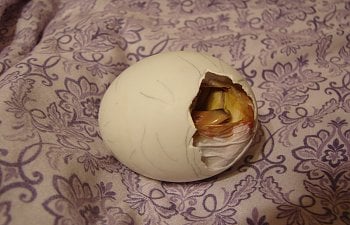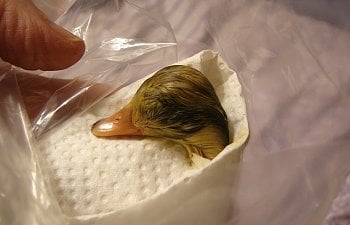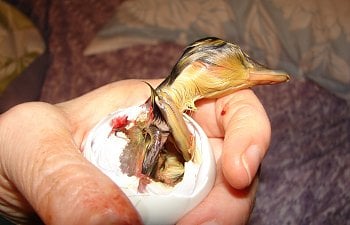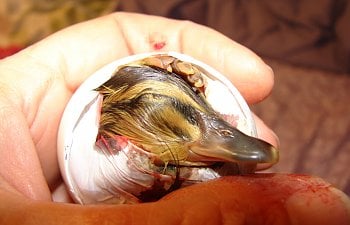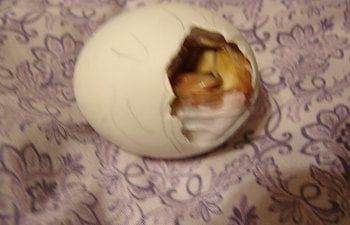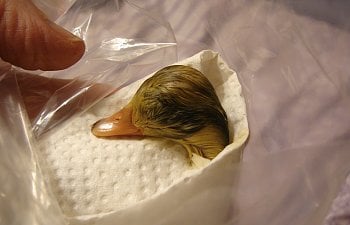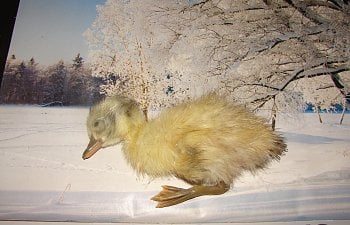To help? To not help? What if a hatching duckling seems in trouble?

My first ever batch of eggs developed well in the incubator. They were beautiful and strong and clearly healthy. On hatch day, right on schedule, they pipped internally, and then externally. Following general online advice, I did not help them, even when they seemed to make little further progress. I waited patiently, expectantly, and soon… WHAT? They were all DEAD?!?!?! My heart broke. Every single healthy duckling was dead. It was too late to help.
I want to share with you the story of how I have learned to recognize when my ducklings are in trouble, and what I have learned to do to help them.
DISCLAIMER: I am not a vet. I am not giving anyone advice. I am NOT telling anyone what he or she should do with his or her ducklings. I am simply sharing my story with you. That is all.
There is a MOVIE at the end. Please read the information below first, so that you can better understand what I am showing in the movie. Thank you.
THE NORMAL BIRTH PROCESS:
I was determined to never again just stand by and let ducklings in trouble die while they were trying to hatch. In order to help future ducklings, I first had to understand the normal birth process. I did a lot of research, and this is what I found.
A normal duckling takes 24 - 48 hours to hatch. Throughout the growth of the embryo and at the start of hatching, the breathing of the duckling is completely provided by a set of blood vessels, which cover a membrane that is just inside of the egg shell. This membrane is just inside the entire egg shell except the part of the egg shell containing the air space. In that area, the membrane is against the duckling rather than against the egg shell. There is a continuous passage of blood in this set of blood vessels on the membrane. The egg shell is porous, and oxygen passes through the egg shell and membrane and into the blood. This is how the duckling “breathes” during incubation.
During hatch day (which can be as long as 48 hours), the duckling SLOWLY switches to air breathing through its bill and lungs, particularly after it has pipped externally. Initially, it is not unusual for the duckling to breathe a few times, and then to make a lengthy pause. This is not an emergency, as during the pause oxygen is provided by the set of blood vessels on the membrane. This is also why a duckling does not run out of air after breathing in the air space - even though the air space holds a limited amount of air. Oxygen is still being received from the blood vessels lining the inside of the egg shell.
Over the extended birthing time, particularly after the duckling has pipped externally, the blood vessels that cover the inside of the egg will SLOWLY stop being used. The duckling will SLOWLY begin breathing with its lungs. As this happens, most of the blood that is in the blood vessels gradually goes back into the duckling. The veins do remain, and eventually dry up. When a duckling hatches normally, there is still a red network of veins visible on the inner side of the egg shell, but there is no blood.
A second process takes place while the duckling slowly begins to breathe air. As it developed during its four weeks in the egg, the duckling absorbed all of the white albumen, but used only a small portion of the yolk. A large yolk remains, typically between or below the duckling's legs near its tail. For a normally positioned duckling, the yolk is at the bottom of egg, away from the air space. The yolk is inside of a thin membrane. While the duckling goes through the hatching process, the yolk and its membrane are slowly being drawn into the body. When everything goes right, the duckling finishes unzipping its shell as the veins finish drying up, and the yolk finishes going into the body. Then the duckling is ready to be born.
HELPING MY DUCKLINGS IN TROUBLE - OVERVIEW
My first batch of ducklings died because they were too big. At hatching time they were too tightly squeezed into their shell, so when they needed to begin breathing air, they simply could not expand their chests (and lungs). They could not breathe, even though their bills had access to air.
My solution - dangerously oversimplified in this paragraph - has been to open the shell and to gently guide the head and neck out of the egg (while disturbing the rest of the duckling as little as possible). This creates a bit more room inside the egg – just enough so that the overlarge duckling can now expand its chest and lungs. But please read on if you are interested; at each step there are some things I have learned to do, and some I have learned not to do. This early in the hatching process the veins have not yet stopped working, and the yolk is not yet in the duckling, and that makes it easy for things to go tragically wrong.
Identifying the duckling in trouble
First, how do I know if my duckling will need intervention when it hatches? In general, I can predict an overlarge duckling if the air space is too small. A small air space means that there simply is not room for the duckling to turn around and unzip its shell.
On the other hand, an apparently large air space does not necessarily prove that there is sufficient free space in the egg. I have seen several instances of a very odd situation. The weight of the egg indicates appropriate dryness according to published numbers. When looking at the egg from the outside, the air space appears ample since light clearly lights up a good third of the egg or more. In reality, light is traveling right under the shell, being reflected between the inner egg shell and the membrane covering the duckling. However, there is in fact no real space. The duckling, like a large mountain, uses up nearly all the room in the air space. Here is a picture of such a duckling.

Before I opened the shell, this duckling appeared to have plenty of room – about a third of the egg seemed empty and lit up when I shone a flashlight on it. I could see the shadow of the little bill in the air space. It was sticking half out of the membrane. I wondered why the duckling did not pip further. I also wondered why the duckling was not pecking at the egg shell at all, just slightly waving its bill back and forth slowly some of the time. This didn't seem right to me, so I opened the egg: The bill was out as far as it could possibly go (then it hit the shell), but the duckling had absolutely no room to move it back and forth, and this is why it didn’t appear to be trying to pip more. It wanted to, and had the energy, but it just did not have room. Note that the marks on the shell are pencil marks, not cracks. This duckling is now a healthy young duck!
Making the decision to help or not help:
To help: Sometimes I can make an educated guess that a duckling will most likely need help. At other times, it’s just a gut feeling. Sometimes I even miss the signals completely and fail to help and the duckling dies. At these times, I plan to help more often in the future.
To not help: Sometimes when I do help, something goes wrong. And, due to my interference, a duckling dies. Sometimes (not often) when I help the duckling has a health issue and dies anyway, or lives and has a handicap – and seems unhappy. At these times I plan to help less often in the future.
Making the decision (either direction - to help or to not help) is not easy. However, if I’m not willing to make that decision at all, I cannot incubate ducklings. If I do not incubate ducklings, none are born. If I am willing to make the decision, some (many) survive, and of those who survive, most grow up to be healthy ducks. So, in the end, I choose to make a decision (in either direction), and that helps the species to continue. That is what nature does. Not every baby survives, but nature strives to continue in spite of failures.
If I have chosen to help, how do I know when it is time to help? If the egg is opened too early, the duckling is unlikely to survive, as bacteria can enter the egg and moisture will exit the egg, and the duckling cannot complete its growth. I have saved one duckling whose egg was opened four days before the day it was "born". I had reason to open that particular egg early - the membrane was incomplete and I knew the duckling was not receiving enough oxygen. It was strong in spite of its partial membrane, and with the extra oxygen it gained by breathing air early, it finished its growth, hatched, and grew up to be healthy.
However, I generally do not help until at least one duckling in the batch has pipped internally. This is, for me, usually within two days of the 28 day hatching period. Most of my healthy ducklings seem to be able to survive intervention at that time, and most of my overlarge ducklings are OK until then.
When at least one duckling has pipped internally, I watch that duckling and all the other eggs closely A normal duckling will move under its covering membrane. When I see a little bill moving under the membrane, but not trying to pip internally, I know it just needs more time. When it pips internally, it will then pip pip pip. Rest. Pipipipipipip. Rest. Yawn. Pip pip pip. Or it will pip a few times and then sleep for several hours and no movement at all is seen. That too can be normal.
If I see a very rhythmic breathing or very rhythmic movement exactly repeated and repeated… I know the duckling is in trouble. In one case, I could see the bill, which seemed to gasp for air inside the air space. Gasp - pause - gasp - pause - gasp - pause - gasp - pause - gasp in exact rhythm that did not vary much. In other cases, I don’t see the duckling breathe, but I do see a very rhythmic movement at the junction between the air space and the duckling. You can see this latter case in the movie below, at the start, where there is an obvious, very evenly rhythmic movement at the edge of the air space. It is my experience that when I see this I often have anywhere from zero to two hours to help the duckling before it dies. It is definitely an emergency. Waiting too long can result in a dead-in-shell duckling. I saw this in that very first batch of ducklings, and two hours later all were dead.
Occasionally there is a duckling that is not positioned correctly in the egg. I find this type of duckling sometimes hard to identify. Some ducklings that are late to pip are just normal, late-to-hatch ducklings. At other times, a malpositioned duckling cannot pip. It can't even show the rhythmic signs of stress because it's head and bill are elsewhere. Sometimes it can't move at all. Therefore, such a duckling can be in distress without showing any outwards signs. At that point, it is a guessing game: is it simply a duckling that needs a little extra time to rest before it pips internally? Or is it a duckling that can’t pip due to malpositioning? And if I help it, and it is malformed, will it have a happy life? That is another of those decisions… to help, or not to help?
In my experience, hatching action begins in the evening. If by 10 pm no one has hatched internally, I sleep well until the following night. If some have pipped by 7-8 pm, I stay up, because they can be fine at 9:00 pm and dead at 11:00 pm or midnight. On the other hand, they may show no signs of trouble and be fine for another 24 hours. For me, the day that they hatch internally (and can be in trouble if overly large) is often day 26. But I am sure this could be different for other people, it is probably dependent on the incubator temperature, breed, and other factors. If they don't show signs of trouble during hourly checks, I go to bed at midnight or 1:00 and set the alarm for a 3:00 a.m. check. Sometimes they are fine till the next day. Sometimes I am yawning and opening eggs.
How do I help? First, I gently open the egg at the air space. This part of the eggshell has no membrane; hence, there will be no bleeding. I use a flashlight to see exactly where I seem to be furthest from bill and duckling. I rub the pointy end of a needle back and forth, and I create a groove. After a short while, the tip creates a small hole. I barely put in the tip of the needle, close to the shell on the inside, and I create a small shell splinter. Then I enlarge that hole using the fat end of the needle. I work very carefully, because sometimes the duckling is a lot closer to the shell than may be apparent.

If the duckling has pipped internally, I can see the bill outside the membrane. Then I very gently pull on it, forward, side-to-side, and front to back, very gently but firmly, to help the duckling bring out its head. I look closely because the head can be entangled in the wing and a foot, and the neck curves and should be pulled in certain directions and not others. The duckling in the picture is now a healthy young drake.
If the duckling has not pipped internally, I look for the bill. I will moisten a Q-tip with bottled water and will gently moisten the membrane. This makes it more transparent and I can see the bill better. I can also see any large blood vessels on the membrane. If I see a bill, and the bill moves and the duckling seems to be just resting, I may have miscalculated the due date. If that is the case, I close the egg with a bit of tape and wait to see what happens. If I see a bill and the duckling seems in trouble, then avoiding any visible blood vessels, I will make a small hole in the membrane so I can reach the tip of the bill. Then I help as above.
Bleeding- IMMEDIATE DANGER. The head is large, and helping out the duckling’s head often will cause the rupture of a small blood vessel on the membrane. The vein can bleed steadily. I have found that a nick that is not treated can continue to bleed for an alarmingly long time, endangering my duckling.
If a vein is broken while I am helping a duckling, I use a hair dryer set on warm and full speed to stop the bleeding in a reasonable amount of time. The warmth and the wind both seem to have an effect in helping the blood coagulate rapidly. Sometimes I adjust the warmth of the air by switching every few seconds from warm to cool and back. I have not tried styptic powder with ducklings, as I am afraid of what might happen if some accidentally falls inside the egg and onto the yolk. I always allow the membrane to rip, rather than cutting it. This is because only small veins will rip. Large veins are tougher and will not rip. Using scissors could cause me to cut a larger vein, which could be disastrous. Letting the membrane rip naturally insures that only smaller vessels can break if needed to let the head through.
When I plan to help a duckling, I always first make sure to have my hair dryer handy. In the movie, the duckling is so large that when I open the egg shell I very lightly nick the underlying membrane. That bleeding is very slight and stops on its own. A moment later, as I help the head out of the membrane, a second vein ruptures and there is more significant bleeding. I immediately use the hair dryer, and the bleeding stops within moments.
NEXT...
Because my overly large ducklings die due to lack of space for inflating their chests, I know that helping the little head come out is often not sufficient to save the life of the duckling. My next step is to gently pull on the little bill and/or the little head with much care to draw the neck out of the egg. Gently!!! If it seems stuck, I work it back and forth very gently to help the duckling unwind. As I do this, I am very careful to look and try to figure out in which direction the head and neck need to face! I have found that if the head and neck are both out of the egg shell, the duckling has sufficient space for at least an extra day - and this is usually enough. I do make sure that the little back can straighten; this helps the little chest to expand well. However, at the same time I am careful to not pull the body of the duckling out of the egg. The duckling must have the blood vessels for another 24 hours, at least, and sometimes for 48 hours (rarely more). The bottom half of the duckling must not be disturbed until the blood vessels dry out and the yolk is fully absorbed into the duckling.

I know I am repeating, but a duckling must have the blood in the blood vessels. It needs the oxygen brought by that blood, as it does not transfer to full lung breathing very quickly. I know a duckling cannot be separated prematurely from the veins that provide its oxygen. Therefore, any help that I give must preserve the connection between the duckling and most of those veins, and any significant bleeding must be actively stopped. I know that the blood in the body and the blood in the veins form part of a single connected system, so that a bleeding membrane can make the duck lose the blood in its body also. For this reason, I don't interfere with the rest of the membrane, and I leave the bottom of the egg strictly alone.
The yolk is not in the duckling yet – This is a SLOW DANGER
The yolk must be absorbed into the duckling, complete with its surrounding membrane. If this does not happen, the duckling will not live. When I have opened the egg to help a duckling in trouble and when I have gently drawn out the head and neck, then I shine a light at the bottom of the egg and I try to look down the duckling’s front. Usually, I see that there is still a part of the yolk, or the whole huge yolk, visible between the duckling's legs. In that case, I have learned that if I simply put the egg back in the incubator, the yolk membrane can become dry (not brittle, simply slightly dry-ish). When this happens, the membrane and egg yolk won't go into the duckling. If they don't go in, the duckling cannot live. My ducklings seem to only absorb the yolk in the presence of humidity - humidity that can be lost when I open the egg shell.
Solution: First, I will use a small amount of tape to place a piece of plastic baggie over the open end of the egg (leaving the head out) so that the moisture already in the egg stays in the egg. I only use a small amount of tape because the egg shell must have air for the membrane. That is how the ducklings breathes! So I can’t cover very much of it up with tape. Then, I add moisture to the incubator - as high as possible. This also prevents the yolk from drying out. I sometimes even add a moist paper towel near the egg. But...
Too dry? Too cool? I have an incubator with a fan. So if the fan falls on the opening I have made in the egg, it will surely dry even faster, and if I have added a moist paper towel, as that dries it will cool the egg - way too much! I have lost ducklings that way, too. So I place the egg in a dry paper towel inside an OPEN plastic baggie, and I lightly moisten PART of the paper towel, particularly that which is not in contact with the egg shell near the entrance to the baggie. Then I make sure to place the opening of the baggie facing away from the fan. This prevents the wind from the fan from reaching the egg and paper towel. I keep all factors in mind and try to do my best depending on the particular circumstances, juggling between more warmth or more moisture.

This duckling is now a healthy young duck.
Water danger: I have learned to NOT spray any water directly into (inside) the egg shell, no matter how dry the yolk may seem, or how clean and distilled and warm the water may be. This can kill the duckling - it seems to go into shock, even if the water is warm and clean. I have also learned that if the entire paper towel around the egg is wet, the duckling can cool too much even with the bag facing away from the fan. So it's a balancing game.
Yolk perforation danger: I am very gentle around the yolk. I have only had this happen once, but I have heard of it happening to others. When I was trying to help an overlarge duckling, I noticed that the yolk had been nicked – most likely, the egg had contained a defect when it was laid, as I had seen yellow shadows during candling throughout the incubation period. However, when I helped the overly large duckling’s head out, he kicked his feet. As he did, the yolk began to ooze out. Within moments, the yolk sack was empty. Right then, immediately, the duckling suddenly died. I have heard from others that have observed the same thing. If the yolk breaks or leaks out, the duckling suddenly dies. And nothing can be done to help. So I am extra, extra careful around that yolk sack! This is also why newborn ducklings must be handled gently and not squeezed. A week later when the yolk has been absorbed, they are somewhat more durable.
THE MOVIE below shows a duckling in trouble.
- At the start, notice the very rhythmic motion at the edge of the air space indicating an overlarge duckling that cannot expand its chest sufficiently.
- Then, I use the flashlight to locate a spot that appears clear of duckling and duckling bill, and then I use a needle to scratch a tiny hole in the egg shell. Even though I am very careful, the duckling is so close to the shell I accidentally nick the membrane slightly as I do that. It is not really bleeding when I see it, so I don't think it needs immediate care.
- I helped the duckling’s head be born. The biggest veins are the strongest, so I just gently guide the head out, letting the membrane decide where to rip. This approach typically protects the largest veins. A small vein begins to bleed, so I immediately control the bleeding with the hair dryer. When the bleeding has completely stopped, I help the duckling’s neck come out.
- At this point the duckling is out of immediate danger, and can expand its chest. I gently wrap it and return it to the incubator to warm up, since it has become chilled while I helped it. After a few minutes, I will return, check on the duckling, and then I will moisten the paper towel and add water to the incubator tray. I only do this after the duckling has warmed up because these actions will cool the incubator for a few minutes.
1:
In this movie, I was working quickly. Speed is necessary because the duckling/egg will quickly grow cold. If I need more time to help a duckling, I will do what I can in a few minutes, and then I will wrap the egg in a paper towel and return it to warm in the incubator for about ten minutes. Then I will help some more. The duckling in the movie is now a healthy young duck.
Then what? After my duckling is well wrapped in the incubator with added moisture, I am done. Although I check on the duckling regularly, I will most likely do nothing for the next 24 hours. The duckling is busy absorbing its yolk and learning to breathe through its lungs.
Danger: the sticky duckling – I check regularly the little head and neck that are coming out of the shell. My healthiest ducklings become dry and silky, though not yet fluffy. These are safe. Occasionally, however, some ducklings become sticky as they dry. The sticky stuff on a duckling will harden like a rock and will make the duckling unable to breathe. If the duckling feels sticky, it is in great danger of dying if/when the sticky part dries. I will wash the parts I can reach with a q-tip and water and a dry paper towel. I am very careful that not a drop of water goes into the shell.
Even after careful cleaning and washing of the exposed neck/head, I have lost sticky ducklings whose skin/down has suddenly dried hard in spite of the cleaning and killed them. To prevent this, I return frequently, because I now know that a duckling that I thought I cleaned enough and that feels ok, may still be sticky when it begins to dry. Also, the duckling can and will stretch, so that more of the sticky parts (not yet washed) can come out of the shell and the danger starts all over again. In my experience, sticky ducklings are harder to save because of the difficulty of cleaning well the parts that are out. The best bet - after cleaning the duckling as much as possible - is to keep the incubator as humid as possible, with additional moist towels near the duckling, to make sure it simply can't dry fully. When such a duckling has fully finished hatching, I bathe it in a sink full of warm water, changing the water several times. I have never (so far) lost a duckling who has made it to the full wash stage, nor have I ever had infections from washing such a duckling only minutes after it fully hatches.
Finishing the hatch: The next evening, I check the yolk again, by shining a light on the bottom of the shell or down the front of the duckling, and trying to peer between its feet. All ducklings seem to need at least 24 hours to absorb their yolk. At that point, I have seen some ducklings with large yolk fully absorb it in only an hour. I have seen others who still needed an additional 24 hours or more. As long as the yolk stays humid, it just takes as long as it takes. But if no progress is seen, do check to make sure there is enough humidity.
When the yolk is absorbed, the birthing process can start. That does not mean I remove the duckling from the shell. This only means that I remove the piece of plastic baggie that kept the inside of the shell moist. Then I place the duckling in its (open) shell in the incubator and let him or her work itself out. At that stage I am aiming for a dry-ish incubator. This helps the veins dry up as the baby fights to work itself free of the shell. The whole process can takes several hours. Occasionally there will be some bleeding, but I haven not had serious issues with this. In most cases, the ducklings will take their time and will separate from their shell when they are ready.
Rarely, there is a very sticky connection between the baby and the shell that the baby cannot break. Sometimes that baby is struggling and pulling so hard that it is pulling its umbilical area partly back out of its belly. So at that point, I think I should help the duckling separate from its shell. BUT, I am really careful, because I have learned that veins that look fully dry can still be open, and the duckling can bleed out. So in most cases I just wrap up the duckling to make it stay in its egg and I wait longer.
If I have a reason to need to hurry the hatch (which is usually not a good idea), first, I check if the veins are dry. If they are not, I know I need to wait longer - this is not optional. If I begin to remove pieces of shell and the membrane does not bleed at all, then I know I can continue. Then I remove more and still it does not bleed, so I know it’s ready to be born. Then…
Danger – sudden bleeding at the last minute: Several times, I have thought the duckling was ready to be separated from that very last piece of eggshell - but when I snipped the duckling free, I discovered I had made a mistake and there was heavy bleeding. That was scary and the duckling was in real danger, because it can bleed very fast.
So now, when I have done everything above, and I have made the decision to help a duckling become separate from the shell... First I check again to make sure there is no yolk showing at all (pink is ok, even if pulled out from the belly a bit). If there is any yellow yolk, waiting is mandatory.
If – and only if - there is no yolk showing and the blood vessels have obviously dried up, then I use a moist q-tip (clean bottled water) to wash the connection of the umbilical area to the veins so that I can identify the several different veins that connect there. Then I will select and blow-dry one vein (being careful to not overheat or overcool the duckling) until it is quite dry and almost brittle before cutting it. I am aiming at a part of the vein that is as far from the duckling as possible while not being connected to the membrane. When the vein is so dry as to be thin and brittle – then I snip it, on the far side of where it is the driest. It can take several minutes to be dry enough. If it's not dry enough there can be surprise bleeding. Then I repeat with the other veins. There is no need to hurry this part of the birth process. The duckling is not in any particular danger.
Finally, over the next few minutes, if the pink umbilical part does not readily go back into the duckling, it may benefit from being moistened with a q-tip and clean warm water a few times.
THE END!!!
EXTRA: Improper placement within the egg.
Sometimes I see a duckling that has not pipped internally when all other eggs set at the same time have done so. I open the air space, and… there is not even a bill moving. In fact, when I moisten the membrane I see that there is not even a bill!

This duckling is facing the wrong way within the egg. Ducklings that are facing the wrong way often have a poorer prognosis. (Rarely, I have heard that a misplaced duckling can sometimes hatch on its own. In my first set, a misplaced duckling did pip externally, but then had the same size issues as the rest of the ducklings.) The duckling in the picture lived through the hatch, but unfortunately it had health issues and passed away within a few days.
When I saw my very first misplaced duckling, all the brothers and sisters had pipped internally, so I opened the last egg at the air space end to see what was going on. All I could see was a huge yolk and a "knee"! Very, very, very careful probing revealed no bill, no head and no neck in sight. I tried to close that end of the egg again using tape and a piece of plastic bag. Then I spend minutes studying the egg. Finally, I noticed a spot that seemed to have a shadow. I opened that spot, and indeed the membrane there was slightly brown, so there was no bleeding when I gently split that membrane. This was where the duckling’s bill was located; he had been rubbing the membrane trying to come out, and had made that spot dry and brown. By the time I made a hole large enough to help the head and neck come out, there had been some bleeding and the egg shell was extremely fragile, since it was now just an uneven ring with a good sized hole at both ends! However, the duckling had a good bit of membrane (and veins) left to support breathing, and it was beginning to breathe on its own also. The extremely fragile duckling/shell ring assembly made it through about 36 hours. At that time, the yolk was fully absorbed, and the duckling was born. It was quite healthy!

Right now, I am helping a third misplaced duckling who was born four days ago. His neck was completely to one side of his body. The bill was at the air hole, but also his "knee" and foot and yolk (at the front of the picture) were at the air hole. The bill was jammed against the shell so tight it even caused slight damage to that point of the bill. Because of the misplacement of his neck throughout the latter part of his growth period within the egg, the neck has not grown correctly. In spite of physical therapy, the duckling holds his head to the side. However, he can now walk, run, and get to food and water easily. Because he is sometimes bullied by other ducklings of the same age, I have placed him for adoption. A kind family has taken him and his sibling companion, and they are doing great!
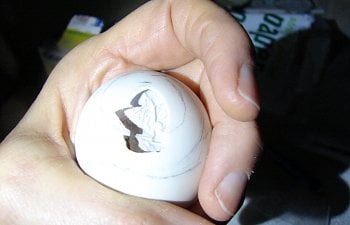
My first ever batch of eggs developed well in the incubator. They were beautiful and strong and clearly healthy. On hatch day, right on schedule, they pipped internally, and then externally. Following general online advice, I did not help them, even when they seemed to make little further progress. I waited patiently, expectantly, and soon… WHAT? They were all DEAD?!?!?! My heart broke. Every single healthy duckling was dead. It was too late to help.
I want to share with you the story of how I have learned to recognize when my ducklings are in trouble, and what I have learned to do to help them.
DISCLAIMER: I am not a vet. I am not giving anyone advice. I am NOT telling anyone what he or she should do with his or her ducklings. I am simply sharing my story with you. That is all.
There is a MOVIE at the end. Please read the information below first, so that you can better understand what I am showing in the movie. Thank you.
THE NORMAL BIRTH PROCESS:
I was determined to never again just stand by and let ducklings in trouble die while they were trying to hatch. In order to help future ducklings, I first had to understand the normal birth process. I did a lot of research, and this is what I found.
A normal duckling takes 24 - 48 hours to hatch. Throughout the growth of the embryo and at the start of hatching, the breathing of the duckling is completely provided by a set of blood vessels, which cover a membrane that is just inside of the egg shell. This membrane is just inside the entire egg shell except the part of the egg shell containing the air space. In that area, the membrane is against the duckling rather than against the egg shell. There is a continuous passage of blood in this set of blood vessels on the membrane. The egg shell is porous, and oxygen passes through the egg shell and membrane and into the blood. This is how the duckling “breathes” during incubation.
During hatch day (which can be as long as 48 hours), the duckling SLOWLY switches to air breathing through its bill and lungs, particularly after it has pipped externally. Initially, it is not unusual for the duckling to breathe a few times, and then to make a lengthy pause. This is not an emergency, as during the pause oxygen is provided by the set of blood vessels on the membrane. This is also why a duckling does not run out of air after breathing in the air space - even though the air space holds a limited amount of air. Oxygen is still being received from the blood vessels lining the inside of the egg shell.
Over the extended birthing time, particularly after the duckling has pipped externally, the blood vessels that cover the inside of the egg will SLOWLY stop being used. The duckling will SLOWLY begin breathing with its lungs. As this happens, most of the blood that is in the blood vessels gradually goes back into the duckling. The veins do remain, and eventually dry up. When a duckling hatches normally, there is still a red network of veins visible on the inner side of the egg shell, but there is no blood.
A second process takes place while the duckling slowly begins to breathe air. As it developed during its four weeks in the egg, the duckling absorbed all of the white albumen, but used only a small portion of the yolk. A large yolk remains, typically between or below the duckling's legs near its tail. For a normally positioned duckling, the yolk is at the bottom of egg, away from the air space. The yolk is inside of a thin membrane. While the duckling goes through the hatching process, the yolk and its membrane are slowly being drawn into the body. When everything goes right, the duckling finishes unzipping its shell as the veins finish drying up, and the yolk finishes going into the body. Then the duckling is ready to be born.
HELPING MY DUCKLINGS IN TROUBLE - OVERVIEW
My first batch of ducklings died because they were too big. At hatching time they were too tightly squeezed into their shell, so when they needed to begin breathing air, they simply could not expand their chests (and lungs). They could not breathe, even though their bills had access to air.
My solution - dangerously oversimplified in this paragraph - has been to open the shell and to gently guide the head and neck out of the egg (while disturbing the rest of the duckling as little as possible). This creates a bit more room inside the egg – just enough so that the overlarge duckling can now expand its chest and lungs. But please read on if you are interested; at each step there are some things I have learned to do, and some I have learned not to do. This early in the hatching process the veins have not yet stopped working, and the yolk is not yet in the duckling, and that makes it easy for things to go tragically wrong.
Identifying the duckling in trouble
First, how do I know if my duckling will need intervention when it hatches? In general, I can predict an overlarge duckling if the air space is too small. A small air space means that there simply is not room for the duckling to turn around and unzip its shell.
On the other hand, an apparently large air space does not necessarily prove that there is sufficient free space in the egg. I have seen several instances of a very odd situation. The weight of the egg indicates appropriate dryness according to published numbers. When looking at the egg from the outside, the air space appears ample since light clearly lights up a good third of the egg or more. In reality, light is traveling right under the shell, being reflected between the inner egg shell and the membrane covering the duckling. However, there is in fact no real space. The duckling, like a large mountain, uses up nearly all the room in the air space. Here is a picture of such a duckling.
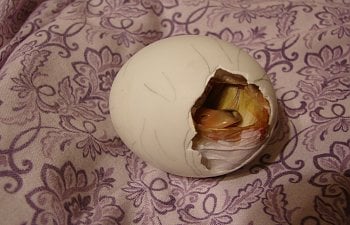
Before I opened the shell, this duckling appeared to have plenty of room – about a third of the egg seemed empty and lit up when I shone a flashlight on it. I could see the shadow of the little bill in the air space. It was sticking half out of the membrane. I wondered why the duckling did not pip further. I also wondered why the duckling was not pecking at the egg shell at all, just slightly waving its bill back and forth slowly some of the time. This didn't seem right to me, so I opened the egg: The bill was out as far as it could possibly go (then it hit the shell), but the duckling had absolutely no room to move it back and forth, and this is why it didn’t appear to be trying to pip more. It wanted to, and had the energy, but it just did not have room. Note that the marks on the shell are pencil marks, not cracks. This duckling is now a healthy young duck!
Making the decision to help or not help:
To help: Sometimes I can make an educated guess that a duckling will most likely need help. At other times, it’s just a gut feeling. Sometimes I even miss the signals completely and fail to help and the duckling dies. At these times, I plan to help more often in the future.
To not help: Sometimes when I do help, something goes wrong. And, due to my interference, a duckling dies. Sometimes (not often) when I help the duckling has a health issue and dies anyway, or lives and has a handicap – and seems unhappy. At these times I plan to help less often in the future.
Making the decision (either direction - to help or to not help) is not easy. However, if I’m not willing to make that decision at all, I cannot incubate ducklings. If I do not incubate ducklings, none are born. If I am willing to make the decision, some (many) survive, and of those who survive, most grow up to be healthy ducks. So, in the end, I choose to make a decision (in either direction), and that helps the species to continue. That is what nature does. Not every baby survives, but nature strives to continue in spite of failures.
If I have chosen to help, how do I know when it is time to help? If the egg is opened too early, the duckling is unlikely to survive, as bacteria can enter the egg and moisture will exit the egg, and the duckling cannot complete its growth. I have saved one duckling whose egg was opened four days before the day it was "born". I had reason to open that particular egg early - the membrane was incomplete and I knew the duckling was not receiving enough oxygen. It was strong in spite of its partial membrane, and with the extra oxygen it gained by breathing air early, it finished its growth, hatched, and grew up to be healthy.
However, I generally do not help until at least one duckling in the batch has pipped internally. This is, for me, usually within two days of the 28 day hatching period. Most of my healthy ducklings seem to be able to survive intervention at that time, and most of my overlarge ducklings are OK until then.
When at least one duckling has pipped internally, I watch that duckling and all the other eggs closely A normal duckling will move under its covering membrane. When I see a little bill moving under the membrane, but not trying to pip internally, I know it just needs more time. When it pips internally, it will then pip pip pip. Rest. Pipipipipipip. Rest. Yawn. Pip pip pip. Or it will pip a few times and then sleep for several hours and no movement at all is seen. That too can be normal.
If I see a very rhythmic breathing or very rhythmic movement exactly repeated and repeated… I know the duckling is in trouble. In one case, I could see the bill, which seemed to gasp for air inside the air space. Gasp - pause - gasp - pause - gasp - pause - gasp - pause - gasp in exact rhythm that did not vary much. In other cases, I don’t see the duckling breathe, but I do see a very rhythmic movement at the junction between the air space and the duckling. You can see this latter case in the movie below, at the start, where there is an obvious, very evenly rhythmic movement at the edge of the air space. It is my experience that when I see this I often have anywhere from zero to two hours to help the duckling before it dies. It is definitely an emergency. Waiting too long can result in a dead-in-shell duckling. I saw this in that very first batch of ducklings, and two hours later all were dead.
Occasionally there is a duckling that is not positioned correctly in the egg. I find this type of duckling sometimes hard to identify. Some ducklings that are late to pip are just normal, late-to-hatch ducklings. At other times, a malpositioned duckling cannot pip. It can't even show the rhythmic signs of stress because it's head and bill are elsewhere. Sometimes it can't move at all. Therefore, such a duckling can be in distress without showing any outwards signs. At that point, it is a guessing game: is it simply a duckling that needs a little extra time to rest before it pips internally? Or is it a duckling that can’t pip due to malpositioning? And if I help it, and it is malformed, will it have a happy life? That is another of those decisions… to help, or not to help?
In my experience, hatching action begins in the evening. If by 10 pm no one has hatched internally, I sleep well until the following night. If some have pipped by 7-8 pm, I stay up, because they can be fine at 9:00 pm and dead at 11:00 pm or midnight. On the other hand, they may show no signs of trouble and be fine for another 24 hours. For me, the day that they hatch internally (and can be in trouble if overly large) is often day 26. But I am sure this could be different for other people, it is probably dependent on the incubator temperature, breed, and other factors. If they don't show signs of trouble during hourly checks, I go to bed at midnight or 1:00 and set the alarm for a 3:00 a.m. check. Sometimes they are fine till the next day. Sometimes I am yawning and opening eggs.
How do I help? First, I gently open the egg at the air space. This part of the eggshell has no membrane; hence, there will be no bleeding. I use a flashlight to see exactly where I seem to be furthest from bill and duckling. I rub the pointy end of a needle back and forth, and I create a groove. After a short while, the tip creates a small hole. I barely put in the tip of the needle, close to the shell on the inside, and I create a small shell splinter. Then I enlarge that hole using the fat end of the needle. I work very carefully, because sometimes the duckling is a lot closer to the shell than may be apparent.
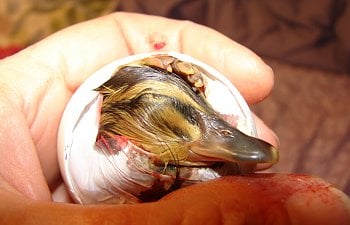
If the duckling has pipped internally, I can see the bill outside the membrane. Then I very gently pull on it, forward, side-to-side, and front to back, very gently but firmly, to help the duckling bring out its head. I look closely because the head can be entangled in the wing and a foot, and the neck curves and should be pulled in certain directions and not others. The duckling in the picture is now a healthy young drake.
If the duckling has not pipped internally, I look for the bill. I will moisten a Q-tip with bottled water and will gently moisten the membrane. This makes it more transparent and I can see the bill better. I can also see any large blood vessels on the membrane. If I see a bill, and the bill moves and the duckling seems to be just resting, I may have miscalculated the due date. If that is the case, I close the egg with a bit of tape and wait to see what happens. If I see a bill and the duckling seems in trouble, then avoiding any visible blood vessels, I will make a small hole in the membrane so I can reach the tip of the bill. Then I help as above.
Bleeding- IMMEDIATE DANGER. The head is large, and helping out the duckling’s head often will cause the rupture of a small blood vessel on the membrane. The vein can bleed steadily. I have found that a nick that is not treated can continue to bleed for an alarmingly long time, endangering my duckling.
If a vein is broken while I am helping a duckling, I use a hair dryer set on warm and full speed to stop the bleeding in a reasonable amount of time. The warmth and the wind both seem to have an effect in helping the blood coagulate rapidly. Sometimes I adjust the warmth of the air by switching every few seconds from warm to cool and back. I have not tried styptic powder with ducklings, as I am afraid of what might happen if some accidentally falls inside the egg and onto the yolk. I always allow the membrane to rip, rather than cutting it. This is because only small veins will rip. Large veins are tougher and will not rip. Using scissors could cause me to cut a larger vein, which could be disastrous. Letting the membrane rip naturally insures that only smaller vessels can break if needed to let the head through.
When I plan to help a duckling, I always first make sure to have my hair dryer handy. In the movie, the duckling is so large that when I open the egg shell I very lightly nick the underlying membrane. That bleeding is very slight and stops on its own. A moment later, as I help the head out of the membrane, a second vein ruptures and there is more significant bleeding. I immediately use the hair dryer, and the bleeding stops within moments.
NEXT...
Because my overly large ducklings die due to lack of space for inflating their chests, I know that helping the little head come out is often not sufficient to save the life of the duckling. My next step is to gently pull on the little bill and/or the little head with much care to draw the neck out of the egg. Gently!!! If it seems stuck, I work it back and forth very gently to help the duckling unwind. As I do this, I am very careful to look and try to figure out in which direction the head and neck need to face! I have found that if the head and neck are both out of the egg shell, the duckling has sufficient space for at least an extra day - and this is usually enough. I do make sure that the little back can straighten; this helps the little chest to expand well. However, at the same time I am careful to not pull the body of the duckling out of the egg. The duckling must have the blood vessels for another 24 hours, at least, and sometimes for 48 hours (rarely more). The bottom half of the duckling must not be disturbed until the blood vessels dry out and the yolk is fully absorbed into the duckling.
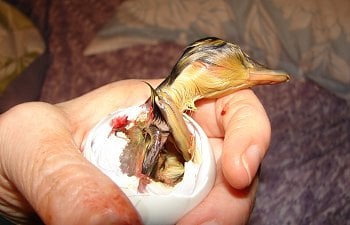
I know I am repeating, but a duckling must have the blood in the blood vessels. It needs the oxygen brought by that blood, as it does not transfer to full lung breathing very quickly. I know a duckling cannot be separated prematurely from the veins that provide its oxygen. Therefore, any help that I give must preserve the connection between the duckling and most of those veins, and any significant bleeding must be actively stopped. I know that the blood in the body and the blood in the veins form part of a single connected system, so that a bleeding membrane can make the duck lose the blood in its body also. For this reason, I don't interfere with the rest of the membrane, and I leave the bottom of the egg strictly alone.
The yolk is not in the duckling yet – This is a SLOW DANGER
The yolk must be absorbed into the duckling, complete with its surrounding membrane. If this does not happen, the duckling will not live. When I have opened the egg to help a duckling in trouble and when I have gently drawn out the head and neck, then I shine a light at the bottom of the egg and I try to look down the duckling’s front. Usually, I see that there is still a part of the yolk, or the whole huge yolk, visible between the duckling's legs. In that case, I have learned that if I simply put the egg back in the incubator, the yolk membrane can become dry (not brittle, simply slightly dry-ish). When this happens, the membrane and egg yolk won't go into the duckling. If they don't go in, the duckling cannot live. My ducklings seem to only absorb the yolk in the presence of humidity - humidity that can be lost when I open the egg shell.
Solution: First, I will use a small amount of tape to place a piece of plastic baggie over the open end of the egg (leaving the head out) so that the moisture already in the egg stays in the egg. I only use a small amount of tape because the egg shell must have air for the membrane. That is how the ducklings breathes! So I can’t cover very much of it up with tape. Then, I add moisture to the incubator - as high as possible. This also prevents the yolk from drying out. I sometimes even add a moist paper towel near the egg. But...
Too dry? Too cool? I have an incubator with a fan. So if the fan falls on the opening I have made in the egg, it will surely dry even faster, and if I have added a moist paper towel, as that dries it will cool the egg - way too much! I have lost ducklings that way, too. So I place the egg in a dry paper towel inside an OPEN plastic baggie, and I lightly moisten PART of the paper towel, particularly that which is not in contact with the egg shell near the entrance to the baggie. Then I make sure to place the opening of the baggie facing away from the fan. This prevents the wind from the fan from reaching the egg and paper towel. I keep all factors in mind and try to do my best depending on the particular circumstances, juggling between more warmth or more moisture.
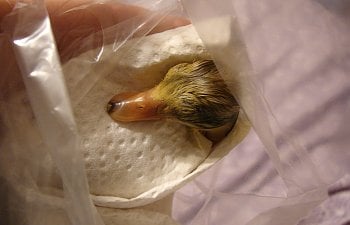
This duckling is now a healthy young duck.
Water danger: I have learned to NOT spray any water directly into (inside) the egg shell, no matter how dry the yolk may seem, or how clean and distilled and warm the water may be. This can kill the duckling - it seems to go into shock, even if the water is warm and clean. I have also learned that if the entire paper towel around the egg is wet, the duckling can cool too much even with the bag facing away from the fan. So it's a balancing game.
Yolk perforation danger: I am very gentle around the yolk. I have only had this happen once, but I have heard of it happening to others. When I was trying to help an overlarge duckling, I noticed that the yolk had been nicked – most likely, the egg had contained a defect when it was laid, as I had seen yellow shadows during candling throughout the incubation period. However, when I helped the overly large duckling’s head out, he kicked his feet. As he did, the yolk began to ooze out. Within moments, the yolk sack was empty. Right then, immediately, the duckling suddenly died. I have heard from others that have observed the same thing. If the yolk breaks or leaks out, the duckling suddenly dies. And nothing can be done to help. So I am extra, extra careful around that yolk sack! This is also why newborn ducklings must be handled gently and not squeezed. A week later when the yolk has been absorbed, they are somewhat more durable.
THE MOVIE below shows a duckling in trouble.
- At the start, notice the very rhythmic motion at the edge of the air space indicating an overlarge duckling that cannot expand its chest sufficiently.
- Then, I use the flashlight to locate a spot that appears clear of duckling and duckling bill, and then I use a needle to scratch a tiny hole in the egg shell. Even though I am very careful, the duckling is so close to the shell I accidentally nick the membrane slightly as I do that. It is not really bleeding when I see it, so I don't think it needs immediate care.
- I helped the duckling’s head be born. The biggest veins are the strongest, so I just gently guide the head out, letting the membrane decide where to rip. This approach typically protects the largest veins. A small vein begins to bleed, so I immediately control the bleeding with the hair dryer. When the bleeding has completely stopped, I help the duckling’s neck come out.
- At this point the duckling is out of immediate danger, and can expand its chest. I gently wrap it and return it to the incubator to warm up, since it has become chilled while I helped it. After a few minutes, I will return, check on the duckling, and then I will moisten the paper towel and add water to the incubator tray. I only do this after the duckling has warmed up because these actions will cool the incubator for a few minutes.
In this movie, I was working quickly. Speed is necessary because the duckling/egg will quickly grow cold. If I need more time to help a duckling, I will do what I can in a few minutes, and then I will wrap the egg in a paper towel and return it to warm in the incubator for about ten minutes. Then I will help some more. The duckling in the movie is now a healthy young duck.
Then what? After my duckling is well wrapped in the incubator with added moisture, I am done. Although I check on the duckling regularly, I will most likely do nothing for the next 24 hours. The duckling is busy absorbing its yolk and learning to breathe through its lungs.
Danger: the sticky duckling – I check regularly the little head and neck that are coming out of the shell. My healthiest ducklings become dry and silky, though not yet fluffy. These are safe. Occasionally, however, some ducklings become sticky as they dry. The sticky stuff on a duckling will harden like a rock and will make the duckling unable to breathe. If the duckling feels sticky, it is in great danger of dying if/when the sticky part dries. I will wash the parts I can reach with a q-tip and water and a dry paper towel. I am very careful that not a drop of water goes into the shell.
Even after careful cleaning and washing of the exposed neck/head, I have lost sticky ducklings whose skin/down has suddenly dried hard in spite of the cleaning and killed them. To prevent this, I return frequently, because I now know that a duckling that I thought I cleaned enough and that feels ok, may still be sticky when it begins to dry. Also, the duckling can and will stretch, so that more of the sticky parts (not yet washed) can come out of the shell and the danger starts all over again. In my experience, sticky ducklings are harder to save because of the difficulty of cleaning well the parts that are out. The best bet - after cleaning the duckling as much as possible - is to keep the incubator as humid as possible, with additional moist towels near the duckling, to make sure it simply can't dry fully. When such a duckling has fully finished hatching, I bathe it in a sink full of warm water, changing the water several times. I have never (so far) lost a duckling who has made it to the full wash stage, nor have I ever had infections from washing such a duckling only minutes after it fully hatches.
Finishing the hatch: The next evening, I check the yolk again, by shining a light on the bottom of the shell or down the front of the duckling, and trying to peer between its feet. All ducklings seem to need at least 24 hours to absorb their yolk. At that point, I have seen some ducklings with large yolk fully absorb it in only an hour. I have seen others who still needed an additional 24 hours or more. As long as the yolk stays humid, it just takes as long as it takes. But if no progress is seen, do check to make sure there is enough humidity.
When the yolk is absorbed, the birthing process can start. That does not mean I remove the duckling from the shell. This only means that I remove the piece of plastic baggie that kept the inside of the shell moist. Then I place the duckling in its (open) shell in the incubator and let him or her work itself out. At that stage I am aiming for a dry-ish incubator. This helps the veins dry up as the baby fights to work itself free of the shell. The whole process can takes several hours. Occasionally there will be some bleeding, but I haven not had serious issues with this. In most cases, the ducklings will take their time and will separate from their shell when they are ready.
Rarely, there is a very sticky connection between the baby and the shell that the baby cannot break. Sometimes that baby is struggling and pulling so hard that it is pulling its umbilical area partly back out of its belly. So at that point, I think I should help the duckling separate from its shell. BUT, I am really careful, because I have learned that veins that look fully dry can still be open, and the duckling can bleed out. So in most cases I just wrap up the duckling to make it stay in its egg and I wait longer.
If I have a reason to need to hurry the hatch (which is usually not a good idea), first, I check if the veins are dry. If they are not, I know I need to wait longer - this is not optional. If I begin to remove pieces of shell and the membrane does not bleed at all, then I know I can continue. Then I remove more and still it does not bleed, so I know it’s ready to be born. Then…
Danger – sudden bleeding at the last minute: Several times, I have thought the duckling was ready to be separated from that very last piece of eggshell - but when I snipped the duckling free, I discovered I had made a mistake and there was heavy bleeding. That was scary and the duckling was in real danger, because it can bleed very fast.
So now, when I have done everything above, and I have made the decision to help a duckling become separate from the shell... First I check again to make sure there is no yolk showing at all (pink is ok, even if pulled out from the belly a bit). If there is any yellow yolk, waiting is mandatory.
If – and only if - there is no yolk showing and the blood vessels have obviously dried up, then I use a moist q-tip (clean bottled water) to wash the connection of the umbilical area to the veins so that I can identify the several different veins that connect there. Then I will select and blow-dry one vein (being careful to not overheat or overcool the duckling) until it is quite dry and almost brittle before cutting it. I am aiming at a part of the vein that is as far from the duckling as possible while not being connected to the membrane. When the vein is so dry as to be thin and brittle – then I snip it, on the far side of where it is the driest. It can take several minutes to be dry enough. If it's not dry enough there can be surprise bleeding. Then I repeat with the other veins. There is no need to hurry this part of the birth process. The duckling is not in any particular danger.
Finally, over the next few minutes, if the pink umbilical part does not readily go back into the duckling, it may benefit from being moistened with a q-tip and clean warm water a few times.
THE END!!!
EXTRA: Improper placement within the egg.
Sometimes I see a duckling that has not pipped internally when all other eggs set at the same time have done so. I open the air space, and… there is not even a bill moving. In fact, when I moisten the membrane I see that there is not even a bill!
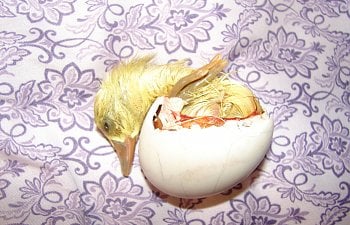
This duckling is facing the wrong way within the egg. Ducklings that are facing the wrong way often have a poorer prognosis. (Rarely, I have heard that a misplaced duckling can sometimes hatch on its own. In my first set, a misplaced duckling did pip externally, but then had the same size issues as the rest of the ducklings.) The duckling in the picture lived through the hatch, but unfortunately it had health issues and passed away within a few days.
When I saw my very first misplaced duckling, all the brothers and sisters had pipped internally, so I opened the last egg at the air space end to see what was going on. All I could see was a huge yolk and a "knee"! Very, very, very careful probing revealed no bill, no head and no neck in sight. I tried to close that end of the egg again using tape and a piece of plastic bag. Then I spend minutes studying the egg. Finally, I noticed a spot that seemed to have a shadow. I opened that spot, and indeed the membrane there was slightly brown, so there was no bleeding when I gently split that membrane. This was where the duckling’s bill was located; he had been rubbing the membrane trying to come out, and had made that spot dry and brown. By the time I made a hole large enough to help the head and neck come out, there had been some bleeding and the egg shell was extremely fragile, since it was now just an uneven ring with a good sized hole at both ends! However, the duckling had a good bit of membrane (and veins) left to support breathing, and it was beginning to breathe on its own also. The extremely fragile duckling/shell ring assembly made it through about 36 hours. At that time, the yolk was fully absorbed, and the duckling was born. It was quite healthy!
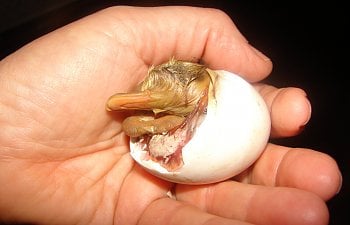
Right now, I am helping a third misplaced duckling who was born four days ago. His neck was completely to one side of his body. The bill was at the air hole, but also his "knee" and foot and yolk (at the front of the picture) were at the air hole. The bill was jammed against the shell so tight it even caused slight damage to that point of the bill. Because of the misplacement of his neck throughout the latter part of his growth period within the egg, the neck has not grown correctly. In spite of physical therapy, the duckling holds his head to the side. However, he can now walk, run, and get to food and water easily. Because he is sometimes bullied by other ducklings of the same age, I have placed him for adoption. A kind family has taken him and his sibling companion, and they are doing great!

